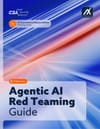🧠 What’s Covered
The document spans 12 categories of threat, including supply chain attacks, permission escalation, multi-agent collusion, memory poisoning, and hallucination chains. Each category comes with specific test requirements, detailed attack vectors, example prompts, and clear deliverables. For example:
- Goal and Instruction Manipulation tests include semantic manipulation, recursive subversion, and data exfiltration via goal inference.
- Agent Orchestration and Multi-Agent Exploitation explores attacks on inter-agent trust, confused deputy attacks, and orchestrator poisoning.
- Agent Untraceability zeroes in on gaps in forensic traceability, log suppression, and obfuscation of downstream actions.
The guide also dedicates space to red teaming setup, reporting templates, and how to scale efforts across agent populations. A Future Outlook section introduces emerging tools like AgentDojo, AgentFence, Agentic Radar, and Microsoft’s AI Red Teaming Agent.
💡 Why It Matters?
Agentic AI systems don’t just respond—they plan, adapt, and act autonomously. This evolution introduces novel risks that resemble security testing for distributed systems, autonomous robotics, and even nation-state cyber threat simulation. The guide enables security teams to treat AI agents as complex infrastructure components, rather than "just another LLM." It also offers a playbook for regulators and enterprise risk teams seeking assurance in real-world deployment contexts.
🧱 What’s Missing
While methodically thorough, the guide largely assumes the reader is a seasoned red teamer or agent system developer. It lacks simplified onboarding for AI governance teams or policymakers who might need a higher-level understanding of threat categories and outcomes. Also, mitigation strategies are mostly deferred to other CSA materials—this guide is strictly about finding the flaws, not fixing them.
🎯 Best For
- Security teams developing or testing autonomous agents
- Risk professionals aligning red teaming practices with AI assurance
- Researchers building benchmarks and automated red team agents
- Developers integrating agents into critical infrastructure
📎 Source Details
- Authors: CSA AI Organizational Responsibilities WG & OWASP AI Exchange
- Year: 2025
- Length: 62 pages
- Published by: Cloud Security Alliance
- Link: CSA AI Organizational Responsibilities Working Group
- License: CC BY-NC-ND (noncommercial use only)


